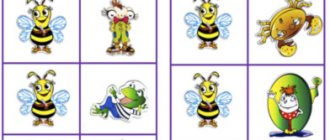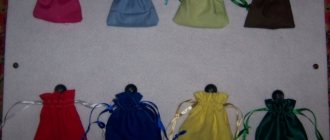Didactic games for children 4-5 years old in kindergarten
Printed board games for children 4-5 years old
Paired pictures
Didactic task. Develop observation skills in children; the ability to find similarities and differences in objects depicted in pictures; activate children's vocabulary: similar, different, identical.
Game rule. Select only identical pictures. The one who doesn't make a mistake wins.
Game action. Search for identical pictures.
Progress of the game . Children sit at a table on which pictures are laid out. There are many of them (10-12), they are all different, but among them there are two identical ones. The teacher asks one of the children to find and name identical pictures and show them to everyone playing. Paired pictures are put aside. Then the teacher mixes all the pictures (they must be upside down) and quietly adds another paired picture. Having laid them out on the front side, he again offers to find the same ones. The difficulty lies in the fact that among the cards there can be very similar, but not the same, for example: cups, identical in color and shape, but one with a handle and the other without a handle; two apples are the same, but one has a stem and the other does not, that is, they have subtle signs of difference that children do not immediately notice.
The game is played with a small group of children so that all the children sit on one side of the table and everyone can clearly see the pictures. To complicate the game, you can offer to find not just one pair, but several pairs of identical pictures. Children talk about objects, note how they are similar and how they are different.
Who's doing what
Didactic task. Clarify and consolidate children’s knowledge about agricultural work; develop thinking, ingenuity, concentration, desire to play with peers.
Game rule. Collect from individual parts a whole picture by type of agricultural labor: a tractor driver plows the land, a combine operator harvests grain, milkmaids milk cows, a cattleman cares for animals, a poultry worker feeds chickens, collective farmers weed a field, etc.
Game actions. Search for the necessary parts of the picture; a story about the type of labor depicted in the resulting whole picture. Competition - who will be the first to put together a picture.
Progress of the game. The game begins with a short conversation about agricultural work, during which children remember different professions and machines that help rural workers in their work. Then the teacher reminds the rules of the game learned earlier in other games with pictures. The complication in this game is that the number of parts increases to 10 - 12.
Here you need to be even more attentive and smart. The one who puts the picture together first wins. He receives a winner badge, such as a star.
Make no mistake!
Didactic task. Clarify and consolidate children’s knowledge about different sports; cultivate a desire to play sports, develop resourcefulness, intelligence, and attention.
Game rule. The winner is the one who is the first to put together a picture (of six parts) about one sport.
Game actions . Finding the necessary parts of the picture, putting them together; competition.
Progress of the game . The teacher has cards depicting various sports: football, hockey, volleyball, gymnastics, rowing. The game is played according to the type of cut pictures, but they are cut differently - in the middle there is a picture with an athlete. It is necessary to select for the athlete everything necessary for the game. Whoever completes the whole picture first wins.
Using this principle, you can make a game in which children will select tools for different professions. For example, a builder: pick up all the tools he needs for work - a shovel, trowel, paint brush, bucket; machines that facilitate the work of a builder - a crane, excavator, dump truck, etc.
The pictures depict people of those professions that children are introduced to throughout the year: cook, janitor, postman, salesman, doctor, teacher, builder, tractor driver, mechanic, etc. Images of the objects of their labor are selected for them. The correctness of execution is controlled by the picture itself: from small pictures it should turn out to be a large, whole one.
Domino
Didactic task. To consolidate children’s knowledge about means of transportation: cars, trains, planes, helicopters, ships, boats, and note their features; continue to develop the ability to play together and obey the rules of the game.
Game rules . The winner is the one who finishes the selection of pictures first, puts them according to the rule: plane to plane, car to car, boat to boat - and never makes a mistake; he receives a chip - a red circle.
Game actions . Finding the right pictures, maintaining the order.
Progress of the game . For this game you need to make cards, like in any game like Dominoes. The card is divided into two halves: each of them depicts different types of transport. The game is designed for 4-6 participants. There should be 24 cards. If there are four players, 6 cards are dealt. The game is played like a Domino game. The one who puts down the last card, while others still have them, wins and gets a chip. When the game is repeated, the cards are shuffled. Children count out 4-6 cards without looking, and the game continues.
Lotto
Didactic task. Systematize children’s scattered knowledge about transport, pioneers, school, pets, and family; activate children's speech, practice the correct naming of objects, use general words: transport, pets, school, family, pioneers.
Game rule . Correctly select objects and cover cells with them on large maps that depict a city street, a pioneer camp, a family, a school, or pets.
Progress of the game . Children take the cards themselves. They choose a driver, at whose signal everyone begins to quickly look for small cards and cover the cells with them. Whoever closes all the cells first wins and gets a chip.
The game is repeated several times, with the cards changing. At the end of the game they count: whoever has more chips wins. The teacher does not forget to remind the children to put all the pictures in the box and put it back in its place.
Hunter and shepherd
Didactic task . Exercise children in grouping wild animals and domestic animals; learn to correctly use generalizing words wild animals, domestic animals; cultivate attention and speed of reaction to words.
Game rules . Select and place on the flannelgraph only those pictures that the hunter or shepherd needs (see figure). Whoever selects all the pictures first wins.
Game actions . Search for the required pictures; competition; use of flannelgraph.
Progress of the game. The teacher explains the rules of the game:
— Today we have a new interesting game. It's called "Hunter and Shepherd". Who is a hunter? Who knows? (Children answer.) Yes, he hunts in the forest. Remember what wild animals you know.
“Hare, fox, wolf, bear, squirrel, tiger,” the children list.
- Why are they called wild? - the teacher asks the children. - Right. Because they live in the forest, far from a person's home. So who hunts wild animals?
“Hunter,” the children answer in unison.
-Who is the shepherd? - the teacher asks the question again. - What animals does he graze?
The children answer, the teacher asks all the children to say in chorus the words domestic animals and wild animals.
- So, the shepherd grazes domestic animals, and the hunter hunts wild animals. Now we will choose a shepherd and a hunter for the game. Who wants to be a hunter? And who is the shepherd? (To begin with, he chooses children who are more active.) Vitya is a shepherd, and Zhenya is a hunter. Fine. Now listen to the rules of the game: on this half of the flannelgraph, on the right there is a meadow where domestic animals graze, and on the left side there is a forest where wild animals live.
At the signal “Look!” Vitya and Zhenya will take and put pictures of animals on the flannelgraph. And you, children, keep an eye on them to see if the pictures are selected correctly. If someone makes a mistake, it means he is a bad shepherd or hunter.
The shepherd and the hunter come to the table. "Look!" - the teacher gives a signal. For the first time you should put a small number of animal species (4-5), next time you need to add 2-3 more species to complicate the task.
At the end of the game you can count how many wild animals and how many domestic animals. In the game, there should be an equal number of cards with images of wild animals and domestic animals.
What's extra?
Didactic task . Teach children to notice errors in the use of objects; develop observation skills, a sense of humor, and the ability to prove the correctness of one’s judgment; consolidate knowledge about working tools.
Game rule . Cover with cardboard only the picture that is unnecessary. The first one to discover the unwanted item wins.
Game actions. Find and close unnecessary items.
Progress of the game . People of different professions are drawn on large maps, and in the cells are the objects and tools they need for work. Among them there are those who are not needed for this profession. For example, in the center there is a drawing that depicts a nurse treating a patient, and in the cells are drawn all the objects necessary for her work, including dumbbells.
Children playing should notice and cover the unnecessary object with a clean square. Here you need to select pictures with professions familiar to children: cook, janitor, driver, combine operator, builder, teacher, salesman, etc. Children exchange cards and the game continues.
When does this happen?
Didactic task . Strengthen children's knowledge about the parts of the day; exercise them in comparing pictures with parts of the day: morning, afternoon, evening, night.
Game rules . According to the word that the teacher says, show the card and explain why he picked it up.
Game action. Search for the desired picture.
Progress of the game. On the table the players have different pictures reflecting the life of children in kindergarten: morning exercises, breakfast, classes, games in the area, sleep, cleaning the group room, sledding, parents coming, etc. There should be several scenes of pictures for each part of the day. Children each choose any picture for themselves and look at it carefully. When they hear the word morning, all the children raise the picture and each one explains why he thinks it is morning: the children come to kindergarten, the teacher is waiting for them, they do morning exercises, wash, brush their teeth, have breakfast, study, etc. Then the teacher says word day. Pictures are raised by those who have an image of some event or activity of children at this time of day: on a walk, working on the site, having lunch, sleeping. “Evening,” says the teacher, and the children raise the corresponding cards.
- Why did you show this card? - asks the teacher of the summoned child.
“Because the mothers came for the children, it’s dark outside,” he answers.
“Night,” says the teacher, and the children pick up cards with pictures of sleeping children.
This strengthens children’s knowledge about the parts of the day. For each correct answer, children receive chips: pink chip - morning, blue - day, gray - evening, black - night.
Then all the cards are shuffled, and the game continues so that the words are called in the reverse order: the teacher says, for example, evening, and then morning, i.e., thereby increasing attention to the verbal signal.
Where can I buy this?
Didactic task . To consolidate children’s knowledge that different goods are sold in different stores: grocery stores, department stores, bookstores (there are different grocery stores: “Vegetables and Fruits,” “Bakery,” “Milk”; department stores: “Shoes,” “Clothing,” “ Fabrics", "Children's World", "Sports Store"); teach children to distinguish stores according to their purpose, to navigate their surroundings; cultivate a desire to help parents make simple purchases.
Game rule. Match the items shown in the small pictures with the names of the stores on the large cards. The game is played according to the “Loto” type. The one who makes no mistakes and is the first to cover all the squares wins.
Game actions. Search, find pictures, cover the cells with them. Competition.
Progress of the game. At the beginning of the game, the teacher conducts a conversation with the children about whether they know where their mothers buy food, necessary things, items, what stores they know, what are the names of the stores that are close to their home, do they help their parents buy bread , milk and other products. After the conversation, the teacher shows large maps on which different stores are drawn. Children learn from store windows what is sold there (some children can read the words bread, milk).
- Now, children, let's play. I will give you small cards, and then you have to say where, in which store you can buy it, bring the card and put it on the big card, to the store where you can buy it. Take your time, look carefully at the picture!
Having distributed the cards, the teacher gives the signal: “Start the game!” Children come to the table and place their cards on the squares of a large map. Where the “Milk” store is depicted, cards are placed with images of bottles, packages of milk, cheese, butter, sour cream, cottage cheese, etc. The teacher checks the correctness of the children’s actions and rewards those who correctly found the right store.
The game helps children learn that everything people need is bought in stores; there are different stores.
You need to know which store is near your home in order to help your parents make simple purchases. Pages: 2
LiveInternetLiveInternet
DIDACTIC GAME “LIVING SOUNDS” PURPOSE OF THE GAME: 1. Formation of a full-fledged sound side of speech: a) development of articulation skills, b) correct sound pronunciation, c) reproduction of syllabic structure, d) development of phonetic perception; 2. Mastery of the elements of literacy; 3. Interconnected formation of phonetic-phonemic and lexical-grammatical components of the language. EQUIPMENT: models of houses made of chipboard, models of sounds in the form of men - “Sounds”, schematic models of sounds in the form of circles in red, blue and green with details - nose, eyes and mouth, showing the position of the lips and tongue when pronouncing a certain sound, object pictures , chips. This game guide is intended for children of older preschool age. GAME RULE 1. “Which house does sound live in?” Several previously studied models of sounds in the form of little men - “Zvukovichki” - are displayed in front of the children. The child chooses “Sound”, pronounces the sound correctly, names the letter that corresponds to this sound and hangs it in the model house: vowel sounds “live” in the red house; in blue - consonant hard sounds; in green - soft consonant sounds. For each correctly completed task, the child receives a chip. The winner was the one who most correctly “distributed” the sounds into the houses. GAME RULE 2. “Who is bigger?” The teacher shows the children a model of a previously studied consonant sound, for example, the sound “P” and asks them to “settle the hard and soft sound “P” into their own houses - blue and green. Then the children are divided into 2 teams and given the task of coming up with as many words as possible with the hard and soft sounds “P”. For each correct answer, the team receives a chip. The team that comes up with the most words wins. GAME RULE 3. “Phonetic tales.” The teacher invites the children to listen to a fairy tale about the vowel sound. For example, “The Tale of the Sound “A””. “Once upon a time there was a sound A. He loved to sing, opening his mouth wide: “A__.” Sometimes the sound A sang very quietly: “A, A, A.” Sometimes - very loudly: “A, A, A.” When the sound A was sad, he sang a quiet, quiet, drawn-out song: -A__A__A__A__A__A__A__. There were times when the sound A played on the drum: Aaaaaaaaa. And the sound A sang lullabies to children. His voice then sounded higher and lower and very, very smooth. Everyone around him liked the sound of A because he opened his mouth wide and sang in different voices.” Then the teacher invites the children to independently choose a vowel sound and compose a fairy tale about this sound. The winner is the one who came up with the most interesting fairy tale. GAME RULE 4. “Riddles of singing sounds, or tell me a word.” In this game, children consolidate their knowledge of the articulation of vowel sounds. The teacher makes a riddle about a sound, and the children must name the sound and show a model of this sound. For the correct answer, the child receives a chip. The one with the most chips wins. An example of riddles about sounds: -The sound opens the mouth the widest... -The sound pulls out the lips with a tube.... -The sound of the lips resembles an elongated circle... -The sound has the widest smile... -The sound opens its mouth and lifts its tongue... -Opens his mouth slightly and pulls his tongue back sound...
GAME RULE 5. “Where is the sound hidden?” In the sound house, the teacher displays the “Zvukovichka” sound model. Children characterize this sound: vowel/consonant, hard/soft, voiced/voice. On the table in front of the children, the teacher lays out subject pictures and instructs the children to choose pictures whose names contain a given sound. The one who finds the most pictures wins.
GAME RULE 6. “Collect the word.” The teacher hands out cards with a picture and empty cells - “houses”. Each child has a box with sound models in the form of circles on the table. The teacher gives the children the task of collecting from models of sounds - “Sounds”, words depicted on the card, i.e. “Place each “Zvukovich” in his own house.” The winner is the one who collects the word the fastest.





